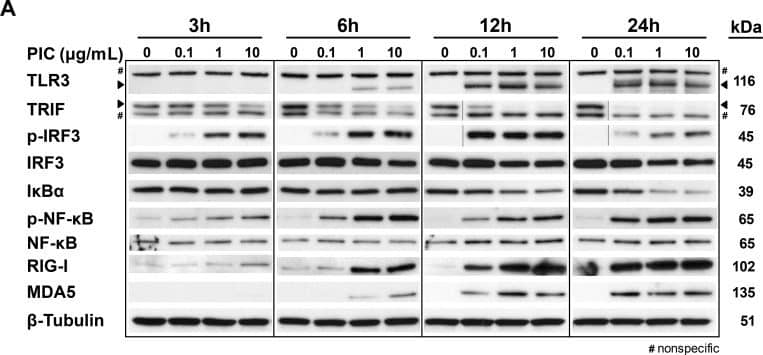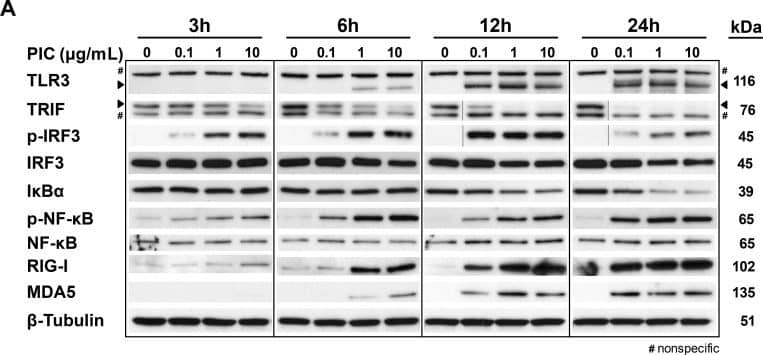Human TLR3 Antibody
R&D Systems, part of Bio-Techne | Catalog # AF1487


Key Product Details
Species Reactivity
Validated:
Cited:
Applications
Validated:
Cited:
Label
Antibody Source
Product Specifications
Immunogen
Lys27-Ser711
Accession # O15455
Specificity
Clonality
Host
Isotype
Scientific Data Images for Human TLR3 Antibody
Detection of Human TLR3 by Western Blot
Poly(I:C) activates the TLR3/TRIF signaling.(A) HLECs were stimulated with Poly(I:C) at 0.1, 1 and 10 μg/mL for 3, 6, 12 and 24 h. Whole cell lysates were analyzed for TLR3, TRIF, phosphorylated-IRF3, total IRF3, I kappaB alpha, phosphorylated-NF-kappa B, NF-kappa B, RIG-I, MDA5, and beta-tubulin (as a loading control) by Western blot. Arrowheads indicate TLR3 (116 kDa, lower band) and TRIF (76 kDa, top band). #, indicates a nonspecific band. Immunoblots are representative of three separate experiments that all showed similar results. (B) Poly(I:C) induces nuclear translocation of NF-kappa B. HLEC were stimulated with medium (NT) or 5 μg/mL Poly(I:C) for 24 h. Immunofluorescence staining was performed using antibodies against NF-kappa B (red) and nuclei were counterstained with Hoechst 33342 (blue). Images are representative of three separate experiments (400x total magnification). Image collected and cropped by CiteAb from the following open publication (https://dx.plos.org/10.1371/journal.pone.0160875), licensed under a CC-BY license. Not internally tested by R&D Systems.Detection of Human TLR3 by Western Blot
Poly(I:C) activates the TLR3/TRIF signaling.(A) HLECs were stimulated with Poly(I:C) at 0.1, 1 and 10 μg/mL for 3, 6, 12 and 24 h. Whole cell lysates were analyzed for TLR3, TRIF, phosphorylated-IRF3, total IRF3, I kappaB alpha, phosphorylated-NF-kappa B, NF-kappa B, RIG-I, MDA5, and beta-tubulin (as a loading control) by Western blot. Arrowheads indicate TLR3 (116 kDa, lower band) and TRIF (76 kDa, top band). #, indicates a nonspecific band. Immunoblots are representative of three separate experiments that all showed similar results. (B) Poly(I:C) induces nuclear translocation of NF-kappa B. HLEC were stimulated with medium (NT) or 5 μg/mL Poly(I:C) for 24 h. Immunofluorescence staining was performed using antibodies against NF-kappa B (red) and nuclei were counterstained with Hoechst 33342 (blue). Images are representative of three separate experiments (400x total magnification). Image collected and cropped by CiteAb from the following open publication (https://dx.plos.org/10.1371/journal.pone.0160875), licensed under a CC-BY license. Not internally tested by R&D Systems.Applications for Human TLR3 Antibody
Western Blot
Sample: Recombinant Human TLR3 (Catalog # 1487-TR)
Formulation, Preparation, and Storage
Purification
Reconstitution
Formulation
Shipping
Stability & Storage
- 12 months from date of receipt, -20 to -70 °C as supplied.
- 1 month, 2 to 8 °C under sterile conditions after reconstitution.
- 6 months, -20 to -70 °C under sterile conditions after reconstitution.
Background: TLR3
Human TLR3 is a 116 kDa type I transmembrane glycoprotein that belongs to the mammalian Toll-Like Receptor family of pathogen pattern recognition molecules (1, 2). There are at least eleven mouse and ten human members that activate the innate immune system following exposure to a variety of microbial species (3). The human TLR3 cDNA encodes a 904 amino acid (aa) precursor that contains a 23 aa signal sequence, a 681 aa extracellular domain (ECD), a 21 aa transmembrane segment, and a 179 aa cytoplasmic region (4). The horseshoe shaped ECD (5, 6) contains 23 leucine rich repeats, and the cytoplasmic domain contains one Toll/IL-1 receptor (TIR) domain. The ECD of human TLR3 shares 80%, 79%, and 77% aa sequence identity with the ECD of rat, mouse, and bovine TLR3, respectively. TLR3 is found in phagosomes (7), where the acidic pH enables binding of internalized double stranded RNA and mRNA from viruses, parasites, and necrotic virally-infected cells (8 - 11). Ligand binding by TLR3 induces receptor dimerization (5, 6, 8) leading to the release of inflammatory cytokines and dendritic cell maturation (9, 11 - 13). TLR3 is expressed in dendritic cells, macrophages, microglia, and astrocytes (13 - 15) and is upregulated by IFN-beta and LPS (9, 14). TLR3 expression is also induced by lung fibroblasts and epithelial cells by respiratory syncytial virus infection (12).
References
- Sen, G.C. and S.N. Sarkar (2005) Cytokine Growth Factor Rev. 16:1.
- Schroder, M. and A.G. Bowie (2005) Trends Immunol. 26:462.
- Hopkins, P.A. and S. Sriskandan (2005) Clin. Exp. Immunol. 140:395.
- Rock, F.L. et al. (1998) Proc. Natl. Acad. Sci. 95:588.
- Choe, J. et al. (2005) Science 309:581.
- Bell, J.K. et al. (2005) Proc. Natl. Acad. Sci. 102:10976.
- Nishiya, T. et al. (2002) J. Biol. Chem. 280:37107.
- de Bouteiller, O. et al. (2005) J. Biol. Chem. 280:38133.
- Alexopoulou, L. et al. (2001) Nature 413:732.
- Aksoy, E. et al. (2005) J. Biol. Chem. 280:277.
- Kariko, K. et al. (2004) J. Biol. Chem. 279:12542.
- Rudd, B.D. et al. (2005) J. Virol. 79:3350.
- Farina, C. et al. (2005) J. Neuroimmunol. 159:12.
- Heinz, S. et al. (2003) J. Biol. Chem. 278:21502.
- Wang, T. et al. (2004) Nat. Med. 10:1366.
Long Name
Alternate Names
Gene Symbol
UniProt
Additional TLR3 Products
Product Documents for Human TLR3 Antibody
Product Specific Notices for Human TLR3 Antibody
For research use only
